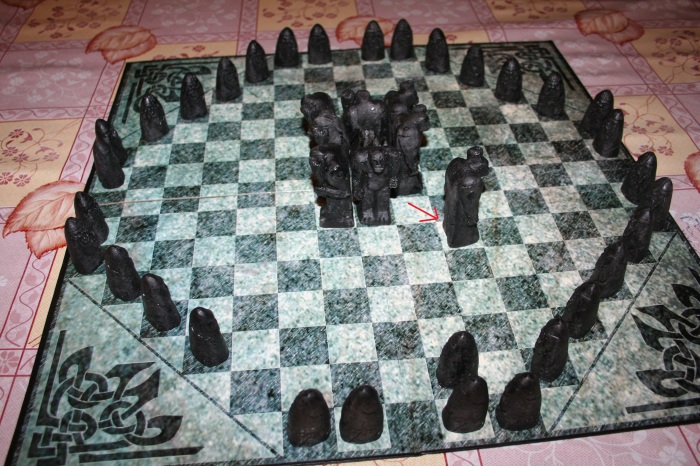Number of Players: 2
Year of Publication: 2002
Creator(s): Trevor Truran – Inspired by the books of Terry Pratchett
Thump…Sorry I mean Thud!
Thud is the first Discworld board game! The first of four (true at time of publication) to be precise. It’s a product, initially, of the genius mind of Terry Pratchett (if you are unaware of Terry Pratchett check out this months update post for more details on him HERE!)
What’s in the Box:
This is the Terry Pratchett game with the fewest pieces.

- A game board. With an Octagon of squares on it.
- 32 Dwarf pieces.
- 8 Troll pieces.
- 2 different thud stones.
- An instruction booklet.
Playing the Game:
The objective of the game is to capture as many of the other players pieces, while losing as few of your own pieces as possible.
To see the rules in full, look here, but I’m going to give a brief overview anyway:
Dwarfs move first; they can move any amount they like, in any direction, so long as it’s in a straight line and there’s nothing in the way, like this:

Then the trolls move; they may only move one square at a time in any direction, as they are large and slow. Like this:

To take another piece a dwarf cannot just go to the same space as a Troll, he must be thrown at the Troll by a line of Dwarfs behind him. Like this:

The number of Dwarfs in the line determines how far the front Dwarf may be thrown.
Trolls take by moving next to Dwarfs, any Dwarfs adjacent to it are taken.

Trolls can also form lines like the Dwarfs and shove the front one of their line, depending on how many Trolls are lined up behind it.
The game is over either when one person loses all their pieces, or (much more likely) when you communally decide there’s no point continuing play because the trolls will never capture their Dwarfs and/or the Dwarfs don’t have enough pieces to form a line to take any Trolls.

Then you add up the amount of points that each player has left on the board; a Dwarf being worth 1 and Troll being worth 4 for their respective players. You then switch sides and play again, the total of both games determining the winner.
Strategy:
Now the strategy of the game is very interesting and also potentially very complex. Not being a master of it I’m just going to focus on one aspect we noticed to be rather crucial if you want to win as Dwarfs.
This is… FORMING A SQUARE… Like this:
 This is super useful and basically the most practical (and likely) way to win as Dwarfs! By forming a square like this you make it very hard for the Trolls to approach you without being taken. Because any angle they approach you from is going to be on a line that you can throw on, and therefore take them.
This is super useful and basically the most practical (and likely) way to win as Dwarfs! By forming a square like this you make it very hard for the Trolls to approach you without being taken. Because any angle they approach you from is going to be on a line that you can throw on, and therefore take them.
To break your square they then have to sacrifice a Troll OR form a shoving line, which is easy to disrupt by adding additional dwarfs to your square to make the distances you can throw greater.
History and Interesting Facts:
- Thud was first mention in Terry Pratchett’s book Going Postal it then became the focus of the following book Thud
- The origin of the game is the Battle of Koom Valley, which it supposedly represents.
- If I’m understanding this correctly Trevor Truran created the game and it was published in 2002. Terry Pratchett, approving of the game, then worked the complete version of it into the Discworld universe, talking about it in Going Postal, published in 2004.
- In Dwarfish it is called “Hnaflbaflwhiflsnifltafl“.
- Which the beginning of the word bears an interesting, and ridiculous resemblances to the name of the Norse game Hnefatafl on which the game is based.
- The release of the book Thud! lead to a special edition of the board game being released, the Koom Valley Edition, where the pieces were produced to look more like the cover art from the book.
- The fictional creator of the game is Morose Stronginthearm who created the game for the Low King of the Dwarfs.
- There is another way of playing the game which we have not covered in this post (and also I have to admit I haven’t played). This is Koom Valley Thud and is played with the same amount of pieces and the same board shape as normal Thud but the starting up is different, as are the rules.
- Fictitiously the game of Thud was devised as an alternative to the fighting.
- Fictitiously the game is supposed to be played once from each side to make up one match in order to teach the merit of seeing things from both sides. This also has real world application.
Also there are ways you can play online on the official site, to do that see here!
To Conclude:
I like Thud, it’s a good game, it has a good concept and is quite well balanced once you’ve got the hang of being each side. However it just doesn’t grab me in the same way some of the other Discworld board games do. I don’t find it half as playable/re-playable. I’m not exactly sure why, because you would imagine it would appeal to someone who likes Chess… And it does… For maybe one game every 6 months.
